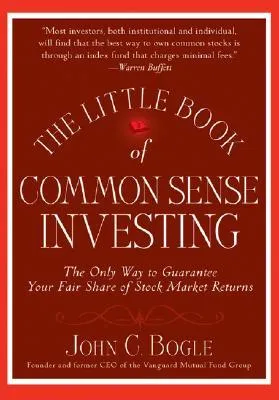The Little Book of Common Sense Investing: The Only Way to Guarantee Your Fair Share of Stock Market Returns
 by John C. Bogle
by John C. Bogle In a long run, index fund trumps stock picking no matter what intelligent brokers may tell you.
The state of long-term expectation for stocks is a combination of enterprise (“forecasting the prospective yield of assets over their whole life”) and speculation (“forecasting the psychology of the market”).
In the long run, stock returns depend almost entirely on the reality of the investment returns earned by our corporations.
In the short term, stock prices go up only when the expectations of investors rise, not necessarily when sales, margins, or profits rise.
The expectations market is about speculation. The real market is about investing. The stock market, then, is a giant distraction to the business of investing.
Ignore the short-term sound and fury of the emotions reflected in our financial markets, and focus on the productive long-term economics of our corporate businesses.
The way to investment success is to get out of the expectations market of stock prices and cast your lot with the real market of business.
The true investor will do better if he forgets about the stock market and pays attention to his dividend returns and to the operating results of his companies.
Owning the stock market over the long term is a winner’s game, but attempting to beat the stock market is a loser’s game.
When we subtract those costs of financial intermediation—all those management fees, all of that portfolio turnover, all of those brokerage commissions, all of those sales loads, all of those advertising costs, all of those operating costs, all of those legal fees—the returns of investors as a group must, and will, and do fall short of the market return by an amount precisely equal to the aggregate amount of those costs.
You put up 100 percent of the capital and you assume 100 percent of the risk. But you earn less than 40 percent of the potential return.
In every single time period and data point tested, low-cost funds beat high-cost funds.
mutual fund management contracts consistently call for advisory fees that are based on a fund’s net assets—not on its dividend income.
While the index fund is remarkably tax-efficient in managing capital gains, it turns out to be relatively tax-inefficient in distributing dividend income. Why? Because its rock-bottom costs mean that nearly all of the dividends paid on the stocks held by the low-cost index fund flow directly into the hands of the index fund’s shareholders.
The odds against success are terrible: Only two out of 355 funds have delivered truly superior performance.
There is simply no systematic way to assure success by picking the funds that will beat the market, even by looking (perhaps especially by looking) to their past performance over the long term.
Reversion to the mean (RTM)—the tendency of funds whose records substantially exceed industry norms to return toward the average or below—is alive and well in the mutual fund industry.
Relative returns of mutual funds are random.
selecting mutual funds on the basis of recent performance is all too likely to be hazardous duty, and it is almost always destined to produce returns that fall far short of those achieved by the stock market, itself so easily achievable through an index fund.
To be 95 percent certain that a manager is not just lucky, it can easily take nearly a millennium.
Buying funds based purely on their past performance is one of the stupidest things an investor can do.
The ETF is an index fund designed to facilitate trading in its shares, dressed in the guise of the traditional index fund.
It would be unfortunate if people focused pinpoint bets on very narrowly defined ETFs. These still involve nearly as much risk as concentrating on individual stock picks.
Today’s winning factors are all too likely to be tomorrow’s losing factors. Investors who disregard RTM are all too likely making a huge mistake.
Successful short-term marketing strategies are rarely—if ever—optimal long-term investment strategies.
My recommendations for investors in the accumulation phase of their lives, working to build their wealth, focused on a stock/bond mix of 80/20 for younger investors and 70/30 for older investors. For investors starting the postretirement distribution phase, 60/40 for younger investors, 50/50 for older investors.
The portfolio that is never rebalanced, however, is likely to provide higher long-term returns.
What if you have a limited time horizon, or are cowed by stock market volatility and tempted to liquidate your stock portion when the seas are rough? Then the hands-off, set-the-allocation-and-stay-the-course strategy of the fixed 60/40 stock/bond asset allocation of the balanced index fund represents an option worthy of your serious consideration.
Your bond position should equal your age, with the remainder in stocks.
It is (or was!) based on the idea that when we are younger, have limited assets to invest, don’t need investment income, have a higher tolerance for risk, and believe that equities will provide higher returns than bonds over the long term, we should own more stocks than bonds.
But when we grow older and ultimately retire, most of us will have accumulated a significant investment portfolio. Then, we are apt to be more risk averse, more willing to sacrifice maximum capital appreciation and to rely more heavily on the higher income yields that bonds have provided over the past 60 years. Under these circumstances, we should own more bonds than stocks.
The way to wealth, I repeat one final time, is not only to capitalize on the magic of long-term compounding of returns, but to avoid the tyranny of long-term compounding of costs.